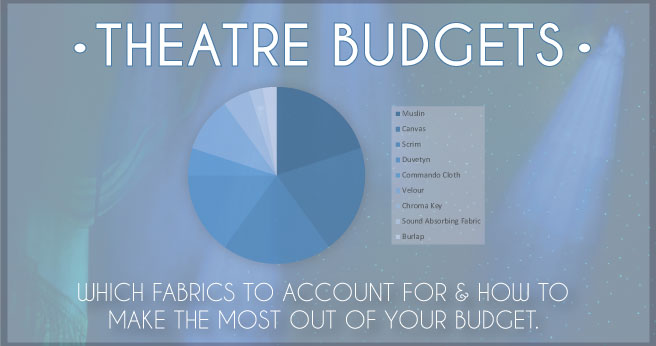Don’t Forget These Line Items in This Year’s Theatre Budget!
Another new year, is here which means it’s time to take a close look at your theatre production budget. According to a National Arts Journalism Program study on theatre budgets, physical production costs can make up 10-20% of your production budget, depending on the size. We know that you want to equip yourself with the best materials for your productions, but also want to stay within your budget. Whether you’re a school, church, community organization or professional theatre, we’ve got some tips to help plan the fabric line items of your theater production budget. Let’s get started on making the most out of your budget!
The Essentials
The best way to make the most of your budget is to account for necessities first. This will help keep your budget realistic. Some organizations know which fabrics to include in their theater production budget, but if you’re a novice in the industry, you can start planning by categorizing which basic fabrics you’ll need for your stage production. The essentials will be for backdrop materials and stage curtains.
- For scenery and backdrop materials, you’ll be looking at Muslin, Canvas and Scrim fabrics. Each provides a different, but essential purpose for theatre and stage productions. As such, when planning, look at which effects you’ll be needing.
- Muslin is used for backdrops and is ideal for stage flats. This is an affordable fabric necessity for theatre productions.
- Canvas can also be used for backdrops, but unlike muslin, does not stretch. This is another budget friendly theatre material.
- Scrim (or theatrical linen gauze) is another option for painted backdrops, but is widely used for various lighting effects and techniques. This fabric tends to be more expensive, but provides a wide range of versatile effects for your production.
- For curtains, you’ll need to choose between flat or pleated fabric. A variety of fabrics are suitable for curtains, so choose in terms of your budget:
- Low-budget: Opt for a flat curtain, which doesn’t have sewn-in pleats. However, be sure to purchase enough fabric—you’ll want it wider than your stage space to allow for natural pleating. This helps created a put-together look. The most economic curtain fabric will be Duvetyn.
- Mid- to high-budget: Pleated curtains create an elegant appearance for any production. Commando cloth is heavier than duvetyn and works for a mid-level budget. Velour curtains offer top quality and are better suited for higher budgets.
The Extras
Now that you’ve nailed down the essentials, you can look at the extra materials you’ll need for costumes, props, and other stage effects. To do this, estimate the number of productions you plan to have next year. If possible, plan which productions and shows you’ll have to understand the effects that will need to be produced—this will determine any extra fabric you’ll need. Here are just a few fabrics you can consider.
-
Effects
- Chroma key (commonly referred to as green screen) is used for post-production visual effects.
- Sound absorption material is used to mask or block sound. Account for this fabric if you need to control the acoustics of your space (musicals, choir, band and orchestra performances, etc.).
-
Decoration and props
- Poly Silk is a good choice for lighting effects and transmitting color. It provides decoration and can also be used forkabuki drapes, backdrops or onstage reveals.
- Burlap is great for adding texture to stage props, and crafting theatrical environments.
- Rip-stop nylon is a lightweight but strong fabric that can be used as a stage backdrops.
-
Costumes
- Metallic foil works well for creating bright and vibrant costumes, suitable for any production. This can also be used for lighting effects, scenery or props.
Remember that most theatres require fabrics to be flame-retardant. To consider how much fabric you’ll need, think about which props can be reused throughout the year, and which productions will require unique materials. If you provide your stage dimensions, your fabric company will be able to advise on the amount of fabric required for your productions. Throughout the year, track your actual expenditures against your estimated costs to help spend more accurately for the next year.
If you’re planning your theatre budget and need some assistance, contact us. We’re happy to help find the right materials for your organization, budget, and project scope.






Thanks for pointing out that the curtain must be way wider than the stage so that it will have natural looking pleating. I will keep that in mind now that we will be needing this for the event of the school that I am in. I was assigned to overlook for the decoration, and this will be to get more students for the next school year. So this tip will ensure that the event will be attractive to passersby.